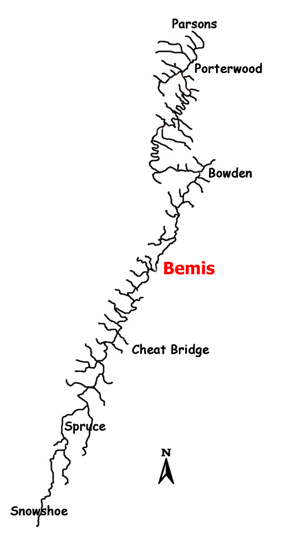
“They’d have cakewalks and square dances. There was always something going on. I think people felt sorry for us in the larger towns. But we felt sorry for them ‘cause they were missing out on what we were doing.”—Calvin Shifflet

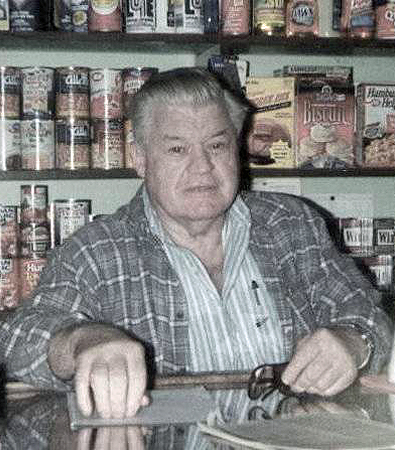
Calvin Shifflet in the Glady post office/store. Photo courtesy Karen Sutton.
Local historian and storyteller Calvin Shifflet of Bemis, West Virginia, has spent his entire life on the Shavers Fork, except for three years in the Army and a couple of years thereafter. Calvin chose to stay close to home, even though he certainly could have made more money elsewhere. But he doesn’t regret it for a moment.
Talking with Calvin, I could ask one question and listen for five, ten, sometimes fifteen minutes as he wove the tale of his life. Through a series of interviews, Calvin shared his life stories, intertwined with a history of Bemis and the local area.
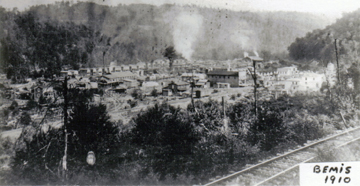 Bemis started off as a railroad construction
camp called Camp Fishing Hawk. Construction of the forty-seven-mile Coal and
Iron Railroad from Elkins to the C&O [Chesapeake and Ohio] connection at Durbin,
Pocahontas County, started in 1900. First train serviced pulled into Fishing
Hawk in late 1902. I think it was in July or August.
Bemis started off as a railroad construction
camp called Camp Fishing Hawk. Construction of the forty-seven-mile Coal and
Iron Railroad from Elkins to the C&O [Chesapeake and Ohio] connection at Durbin,
Pocahontas County, started in 1900. First train serviced pulled into Fishing
Hawk in late 1902. I think it was in July or August.
The town was built by the Rumbarger Brothers: Robert R., John J., and Frank T. were sons of Jacob Rumbarger Sr. There was also a fourth son—he must have been a younger one—Jacob Jr. In 1904, a large sawmill was constructed at Fishing Hawk, which is where that large stream comes down the lower end of Bemis and dumps into Shavers Fork of Cheat River.
-The town of Bemis just 6
years after the sawmill (just left of center) and post office were built.
The
original town plan consisted of thirty employee houses, a large company store
(just right of center)
and four large houses for company executives. Photo
courtesy Calvin Shifflet.
When they got a post office in 1903, they
dropped the Camp and called it Fishing Hawk and with the help of Senator Stephen
B. Elkins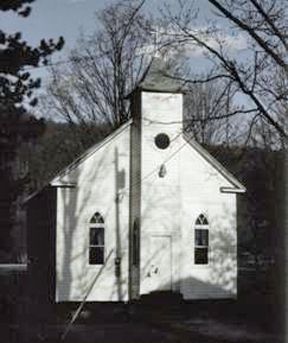 had the name changed to Bemis in September of 1906. The name change
was an honorary sort of thing. J.M. Bemis’s general manager, Mr. Koch, wrote to
Stephen B. Elkins and thanked him for changing the name.
had the name changed to Bemis in September of 1906. The name change
was an honorary sort of thing. J.M. Bemis’s general manager, Mr. Koch, wrote to
Stephen B. Elkins and thanked him for changing the name.
This information says over thirty two-story houses were built for company employees. A large two-story company store with offices above was built and four large two-story houses were built for company officials. School and church was also constructed immediately. A steam-operated forty-five-kilowatt direct-current electric-generation plant was purchased from Alice Chalmers’ company to provide electricity for lighting houses and the sawmill.
A large band mill was soon in use for increased production. This operation produced lumber, pulpwood and tanning bark. January 1, 1906, a formal buyout was made by J.M. Bemis & Sons from Bradford, Pennsylvania. The purchase price, $600,000—$100,000 down and half million balance—was to be paid in lumber shipments of 10,000 feet per year until the balance was paid to Rumbarger Brothers. This operation continued until February 1, 1921. The Bemis family then moved their operation to Robbinsville, North Carolina. It was still in operation in the 1990s.
The town church, built in 1904. Photo courtesy Calvin Shifflet.
The first schoolhouse and church was built in 1903 by the Rumbarger family. No saloons or drinking establishments were allowed until 1921 when J.M. Bemis and Sons moved operation. The first schoolhouse was destroyed by fire in approximately 1931; the second school was constructed immediately as a three-room school. It was a ten-year school until 1942. The original land plot contained forty-five acres and it included the entire town.
I have a picture of the original store. It says H.J. Bemis General Store. That was Henry Bemis, J.M. Bemis’ son. In the windows you can see Rumbarger Brothers. The doctor’s office was upstairs and I understand Mr. Bemis’ office was upstairs. But you could still see Rumbarger stenciled in the windows. The Rumbarger Brothers, instead of Mr. Bemis, mostly built the town.
They came from Coketon over in Tucker County. In fact, that was part of the name of the operation . . . Coketon Lumber Company. Also some of the deeds were to Rumbarger. The railroad came into Bemis in, I think, August of 1902, and they had already bought this timber. I understand it was a small circular mill there.
The Rumbarger Brothers immediately installed a large band mill. According to this one book I have, Bemis sawed more timber than any other mill in this area. They moved out to North Carolina and West Virginia Pulp & Paper Company took over the operation and ran it until 1926 or 1927. They hauled everything from Bemis back up to Cass ... the big operation up in Cass. This was later the Mower Lumber Company operation.
First mines were opened by Monserat Coal Company in the early 1930s and later Davis Coal and Coke, then the Walker Coal Company, which moved operation to Bemis in 1939 and ‘40. This mine closed for good in November of 1950.
Billy Green Coal Company is located between Bemis and Glady on Shavers Mountain; opened in 1935, ceased operation in 1942. Several other smaller contractors mined for coal up into the 1980s. Walker Coal Company ran two shifts employing approximately sixty to eighty men. The Billy Green Company employed about the same. Both mines were unionized around 1940. After the Bemis outfit left, we didn’t have electricity until November of 1950.
It was a big let down after the mines shut
down 1950 in November. The younger people started moving out. Older people,
seemed like, stayed on at Bemis. They didn’t have anywhere to go . . . just
stayed and hung on, including my parents. But when I was growing up, there
was around 250–300 people up there, same as Glady. One time for a project
for school we did the population of Bemis. I think it was right around 300.
School
was the Center of Everything
They had what was called a ball diamond. I
remember they had a volleyball team, a softball team, pie socials . . .
Seems like there was a pie social every month to raise money for whatever.
PTA [Parent Teacher Association] Socials helped finance the school.
Bemis,
with school and playing field at left.
The Bemis lumber company donated the
property for the school. It was in pretty sad shape. The principal, Jason
Meadows, and the older boys cleaned it up. There were all kinds of holes and
rocks to move to make it so you could play anything—ball or volleyball. It
seems to me there was a certificate that used to hang in the hallway. It was
a Model A School . . . ‘Course it was a secondary school. I don’t know how
many schools had that certificate but Bemis did because they were doing so
many extras activities. They’d have cakewalks and square dances. There was
always something going on. I think people felt sorry for us in the larger
towns. But we felt sorry for them ‘cause they were missing out on what we
were doing.
Head of
the Cheat River
Bemis had a ball team in 1908. In my time
it was just softball. We didn’t have enough room or flat land to have a
really good ball diamond. We had teams even after I came back from the Army.
We played Highland Park in Elkins, and we played the prisoners in
Huttonsville, the medium security prison. We played them about every summer
and got beat pretty bad ‘cause they had a really good ball team.
When we couldn’t play anyone else, we’d
play Whitmer. We’d play ball awhile and fight awhile. I remember the last
game I played over there turned into a donnybrook, over what I don’t
remember. I was twenty or twenty-one. Before that we played Glady. They’d
let school out and
In the summer, we all learned to swim in
the Cheat River, as we called it. In fact, I didn’t know it was Shavers Fork
till I come out of the Army. The “head of Cheat River” is what the residents
in Bemis always called it. All the boys, girls too I guess, learned to swim
almost as soon as we started to school. One way or another you’d learn or the big
boys would pick you up and throw you out in there, making sure you’d swim
back to the bank or they would help you. We ran around and built log cabins
in the woods, swung on grapevines and fished, naturally. All the young boys
in this area grew up with a fishing pole and a gun in their hands to fish
and hunt.
Calvin and two of his brothers, Orual and Clarence in front of Calvin’s
Bemis store. The store opened in 1961 and still serves the small community
today.
Bemis Weathers Floods
They built the floodwall in Bemis in ‘08. I
heard someone talk about it and was always wondering where it was. I was
looking at this photo one day and I found that thing. Forty-two. I can
remember very well. It rained all night at the head of Fishing Hawk, washed
all the track out. It (water) was in that big brick building in Bemis—clear
to the first floor—it was a full basement.
It shut the mines down. Walker Coal Company was
running full blast then, and about all the people even at Glady was employed
there. It washed all the track out; the mines were shut down. They had to
rebuild the grade where they’d just cut it right along Fishing Hawk. It washed
all that out.
In the mines, I remember, it drowned one pony.
They had mine ponies. One of the ponies was trying to get over to the other side
where the other ponies were. I remember us kids going to see where that pony was
lodged in the trestle. No lives were lost, but we lost the one pony.
They were probably a good week getting that
roadbed built back. All that coal from Hickory Lick and up at the head of Valley
Head—Bethlehem Steel mines—all came through Bemis. The tannery, the lumberyards,
pulp yards . . . they couldn’t haul nothing till they got all the track rebuilt
at Bemis. I remember my Dad -- it seemed he was working day and night.
The water from Fishing Hawk came right through
the middle of town. It was not in anybody’s houses.
It came down the road, run down through the side and back into Cheat River at
the lower end of town. There was a big culvert and ditch in the middle of town
put in for the millpond. The railroad culverts carried a lot of the water as
well as the culvert. I remember getting up that morning -- school went right on,
kids walking through the water up to their ankles. But it was just a mess for a
lot of people to clean up in their yard.
In the ‘85 flood, it tore at the bridge in
Bemis and almost was ready to come down into town. The rain was more
concentrated in the exact south so it affected the Shavers Fork more than it did
Fishing Hawk. It didn’t come over into town like it did in ‘07 and ‘42. The
trees—it washed gobs of trees out. And then they’d go through this
superstructure: the old bridge would rattle and creak and bang. Everybody would
think it’s gone and it held right on. They’d embedded it into the solid rock
over here, and on this side it was just a cement abutment. It’ll be there for
another hundred years till something moves it, if ever. The state road came in
and repaired it. It messed all this up. It ruined the beach. Now it’s full of
boulders and rocks.
They gave the [evacuation] order in ‘96. A guy
called me and said the water at Cheat Bridge was now higher than it was in ’85,
but the river started to go down. It was up in the cabins in Bemis, didn’t hurt
anything, about like ‘85. All over the floors in two, three camps.
Here it is [in his diary]: “The National
Weather Service notified people to evacuate. My brother and the Coopers
refused.” It was on Friday January 19, 1996. “Water dropping fast. Tore up the
field behind my store. Rolled my brother’s truck over into my property.”
He come over in ‘16 and stayed until ‘18, then
he went back to Virginia. Him and Mom
-
Joseph and Rosa Hansbrough Shifflett, Calvin’s Parents. This picture was
taken in Beldor, Virginia in 1919-20. They later moved to Bemis in 1925 and
lived there until their deaths in 1965 and 1983.
Photo courtesy Calvin Shifflet.
My dad was always going back, going back. He’d
get a little too much to drink, and he was like that song about that one crazy
guy who made the songs . . . Daddy’d let out a big whoop—and I can’t remember
how it goes now—he’d say, “I’m going back to old Virginia, getting out of West
Virginia. I’m going back to old Virginia . . . ”
He’d thump his chest and say, “I’d whoop any
son-of-a-bitch from West Virginia.”
We’d say, “Dad, the three of us is from West
Virginia.”
And he’d say, “Well I’d whoop any of you, too.”
He was a section
hand through Bemis. Never went any farther than Bemis. Three of his brothers
were foremen at one time, another one at Cheat Bridge and one other one
somewhere else. They’d hire just about anybody, but you had to have a foreman
who knew how to do everything.
There was six boys in our family, just three of
us left. Six boys and no girls. People used to ask Mom if she wished she had
some girls around the house and she said no. ‘Course we grew up pretty rough in
Bemis, you know. She just turned us loose and either you make it or you don’t.
With the girls it was a different story.
All of us went into the service except the
oldest—he was born crippled, badly crippled—and he lived twenty-four years
before he died. He couldn’t talk. They never could figure it out. We took him to
a couple different places but they never could figure it out. If it was today,
I’m sure that there would be all sorts of scientists wanting to study him. But
back then it was during the Depression, and Mom had to take care of him like a
baby for twenty-four years.
It was pretty
rough living in these two towns. If it wasn’t for Franklin Delano
The name of it was Jewell’s Department Store
and you could buy anything there. We had two years of high school, as we called
it, and the teachers had to stay there during the winter. They had a couple
rooms and medicine, restaurant, post office, store, hardware. That’s
where you had to go to get your “relief.” They’d give you bags of flour, real
rough coarse flour. It wasn’t really refined all that much back then.
Calvin with his dog, as a boy in the 1940’s. Photo courtesy Calvin Shifflet.
And powdered milk. I really liked that powdered
milk because it was better than no milk I guess. We had good clean spring water.
I can remember coming home from school, walking from school to the house, and
I’d have a sandwich and some of that powdered milk. It wasn’t white looking like
it is now; it was always green looking. But I really liked that old powdered
milk. Now I won’t have nothing to do with powdered milk, powdered eggs, powdered
mashed potatoes.
They’d give you bags of rice, cans of peanut
butter. You had to mix the peanut butter. It’d be solid, and oil would be on
top. It was just like that with margarine—you had a pack of red dye, orange
dye—and you put it in there and mixed it with your hands. It wasn’t a thing
except shortening, and you’d mix it up. I used to love to do that and Mom liked
it because I’d be helping her too. I’d take that little packet of powder and
sprinkle it on the margarine and turn it over and sprinkle the rest. You take
your hands and knead it, and that was your margarine. The government stopped
that because it wasn’t very sanitary. Even the restaurants were doing it that
way. No more squeezing the margarine. Back then there was an open-topped pitcher
with milk to put in your coffee but they put a stop to that too.
That relief truck saved the day in Bemis and
Glady. The farm folks did all right, but in the city—everybody had a little
garden—that wasn’t enough. We called it Roosevelt’s relief truck and boy when it
come, it’d subsidize you. You could get by. They’d even give you clothes. I got
a picture of me, in W.P.A. work suit. It was khakis, like army khakis, but it
was one piece. I called it a relief suit. I’m about five and there’s a picture
of me watching some folks playing volleyball. They had nowhere to go and no
money to get there. Talk about hard times.
The Depression ended in ‘38–‘39—they say on the
talk shows and radio and whatnot—but not in Bemis and Glady. That was ‘41–‘42.
All the eighteen to twenty-year-olds were heading for the service. It opened up
jobs and made jobs getting ready for the war. Most everybody went to Baltimore
and Cleveland.
World War I,
according to the old timers, was when the first coal mine went in. I think it
was Walker Coal Company. They had mines south of Bemis down at Flint. Then it
started to peter out at Flint so they moved to Bemis in ‘39–‘40. They had a huge
company store that is tore down now. The mines ran until November of ‘50.
There was still a lot of coal, but they had a
hard time selling it because they had a hard time washing it. It [coal mine]
supposedly was shut down until they put washers in and they never re-opened it.
I don’t know what happened.
Walker’s mine was on Cheat Mountain and Billy
Green’s was on Shavers, right above Bemis, at the top of the hill. They ran in
the ‘30s and part of the ‘40s and they strip-mined until just a few years back.
And they had a deep mine, but that ended the mining period then.
Auger holes: a series of auger
holes going into the mountain after a strip mine job is finished. Auger holes
were used once the ‘overburden’ became too much and strip mining was no longer
economical. The height of the auger holes is determined by the size of the coal
seam. This mine was located near Fish Hatchery Run.
I was in a mine one time. My oldest brother, he
was in day work, where what you loaded was what you got paid. So he’d go in on
Sunday. Them days you had to drill your own holes and load, I think they called
it Monabelle or something, like dynamite. They’d shoot down what coal was cut
and you could load what cars were there—they’d hold about two tons—and you’d
load it on up. I went in on that Sunday . . . that hot wire
was over your back all the time. The coal was never more than forty-some inches
and everything was on your knees and crawling. We come through a water hole—that
was at least 440 or 660-volt hot wire—if you touched that it probably would have
fried you in that water hole.
You just done your own shooting, you see. Back then you just got
paid for what you loaded, so you loaded that car. If you had two cars you loaded
two. Maybe you had four ton, and you’d like to have three cars. Well, some days
you could get it, and some days you couldn’t. You had a little weight-check with
your number, with a hole in it. You’d stick that in that nail and you’d stick
that on the car—it was oak or locust, some real hard wood—and you’d drive a big
nail in it and bend it. You’d carry your weigh-checks on you: it was like a
safety pin but bigger, and it had your checks. You’d take it off and stick it on
your nail.
They had a sheet up in front for eight, nine,
ten—and you was number eight, and they’d have one ton 1,200; one ton 1,400, and
then you got credit. At the end of the day, they’d total it up and turn it in to
the company store—it set across from where the brick building was. Everyday the
supervisor, he would bring all those weigh-sheets down, and that’s what you got
paid by. They took out some for light and for any dynamite—they’d charge you for
that.
When you shoot the coal, you could see the dust
in the air, and no masks. No one wore any masks. They had a little air
circulating, which was required—the federal mines inspector made sure they had a
little air circulating—but it helped very little. You’d shoot—you’d have those
lights with the battery over your head—and you’d shoot and get back out of the
way and touch it to the battery to shoot. Then you’d walk back over—the coal
dust was still up in the air—you know you was breathing it, even way back over
there.
Eventually you went in, putting the coal into
the cars, pushing the track on up to the face and throwing the dust off to the
side … That was my one day experience and I decided that wasn’t going to be my
career. I know we went in and we loaded up what he shot down. And then we
crawled out and washed up. The mine opening was right next to Fishing Hawk—the
creek there that runs into Bemis—and we washed up.
That was my mining career. For one thing, I
couldn’t stand it going back in under the mountain—three feet high with a hot
wire going above you—working with that dust around you.
You went to the company store, and if you
stayed in the red, they’d tell you what you could buy and what you couldn’t buy.
Most of them sent the kid with a big list. If you were in the red lines, you got
what they wanted to give. If you were in the black, more power to you, anything
you ordered, that was fine.
A lot of guys didn’t have the tonnage or maybe they missed a day,
and that put them behind. I know lots of them there that never even had an
envelope. They had a brown envelope: your time with deductions. They didn’t even
ask for it; they knew they had it coming. They stayed in the red. But that was
the way of life.
Boy that song . . . that fits the company store
in Bemis. That, “Sixteen tons and what do you got?” Only thing is, you could
never get sixteen tons because you could never get the cars. And the thing is,
the guys that were in the red got the cars over you. They was in the red and the
other guys were taking money and going to Elkins and spending a lot of it. So
you might get two cars and that guy in the red got the third car because the
superintendent, his mother-in-law owned the mines. His daughter took care of the
time, and her and her husband run the company store.
Army
Life at Fifteen
I already had my stuff fixed up to get into the
military. I was fifteen, and I had it doctored up so I was eighteen. I washed
that coal off and said, “Boy that’s the first and last trip into the mines for
me. There has got to be a better way to do it.” But that was the way of life
there. Your Dad take you in; your older brother take you in. They had to take
you in until you got a miners card.
The next day I caught the school bus down to
Elkins, and instead of going to school, I went to the recruiting office. That
night I was in Fairmont, and I’d been accepted. The next day I was in Ft. Knox,
Kentucky. There was a recruiting office in Elkins. It was at the post office. My
brothers were in the Navy, but I didn’t like the water so I headed for the Army
office.
I was born in 1933, and I took a little bleach
and dropped on it with an eyedropper. This fellow was advising me and told me
what to do. He told me to put some white vinegar to neutralize the bleach and he
lined it up in the typewriter. He said all you have to do is hit that ‘0’ and
that jumped me from fifteen to eighteen. And that put me in.
So I went down to the sheriff’s office and he
said, “Looks like you’ve been doing some doctoring here.
I said, “Yeah.”
And he said, “You want to get into the Army
that bad huh?”
I said, “Things are pretty tough at home, and
I’ve got to get into the service.”
When we got done he said, “Fifty cents.”
I said, “I ain’t got but a nickel.”
There was a box where they put the money in for
the Photostat. He reached into his pocket and put fifty cents from his pocket
into the box.
He said, “Good luck to ya.”
Years and years later, we had a drink at the
VFW [Veterans of Foreign Wars], and he had forgotten all about that. He had
gotten pretty far in politics.
He said, “There was several boys that did
that.”
Only bad thing was that my Mom and Dad didn’t
know where I was. We didn’t have phones, and I couldn’t call them no way. But
the first thing they made you do in the Army was to write our folks. And they
would make sure that you sent that letter out. My Mom could have had me sent
home in a heartbeat but she didn’t.
I cleared the issue out later on because I
didn’t want to bamboozle the government by getting Social Security three years
early. After I got out, they drafted me again, and I had to explain everything.
They sent it over the draft board, let them know what was going on. I was
walking a tightrope for a while there; I was thinking that I was going to have
to go and pull another two years! Done pulled three.
I never heard no more about it. I was worried
about it for a bit, about them withholding my veteran’s benefits, but it never
did catch up with me.
Calvin served in the Army Signal Corps
for three years, then worked in Baltimore for a couple of years before returning
to Bemis. He “couldn’t stand the cold out on those piers shifting those barges”
in the winter, and after he went to work for Glen L. Martens, he couldn’t stand
the heat: “It [Baltimore] was the hottest place in the summer I ever was at.
It was the coldest place in the winter I was ever at either. Just a different
cold. And the heat? Just muggy. You couldn’t hardly get your
breath.” Matt: How’d you meet your
wife?
Calvin:
We started going together right after I went into service. I came back on
furlough. She was still in high school. Her and her cousin and a girl who lived
across the street in Bemis, they all went and lived with two aunts of hers in
Baltimore. That’s where they would stay until they got situated.
I was working on
the railroad, the B&O Railroad, and we got married. I still was working on the
railroad. We stayed two years, and I come back because you could hardly get your
breath.
They had just sent
those big matador missiles to Cape Canaveral, Forida. We’d put them in big
crates and fasten them down and cover them with tarps—we had these big grayish
brown tarps.
One day it was so hot you couldn’t get your
breath. I drug a box of tools and a fan around on a buggy. I come in that night,
and we had our first child born, a girl. I come in and she said, “What do you
think about going back to Bemis?”
I said, “I was ready the day I come out here.”
So I said, “Next week Monday I’m going to turn in my time.” And I turned in my
two weeks notice.
Back home
there were few jobs, but Calvin found work at Dutch Oven in Elkins, among other
work,
I built the store in Bemis in 1961 and still
operate it. My wife and I took this store and [Glady] post office over in 1977.
We’ve been here ever since. It was founded in 1886, one of the older Post
Offices in West Virginia, I would say.
You’d be amazed at how many toothbrushes I sell
over here at the store. They come all the way over here, and they forget their
toothbrushes, especially the women. During those summer camps, they come in and
they say, “Boy I hope you got toothbrushes and toothpaste.”
‘Course I sell as much of that as anything else
you can think of. Or they run out of ketchup or mustard or they need some
-
George Rowan was half Indian and was a bit of a drifter. He did odd jobs
in the community and lived there for a while. Occasionally he would perform a
bear dance. Although he certainly was eccentric, he was a trusted member of the
town. Cathy Phillips, Calvin’s daughter, remembers that he was like a surrogate
grandpa to her.
Bemis Returns to Camping
The town was
almost completely dead until the hunting camps and fishing camps all started.
Last count I had there were over 200 between Glady and Bemis, counting those in
the town of Bemis. I counted along the road and places you can’t see then
checked with Ron White. He has a big campground, and he had about fifty.
That rejuvenated Bemis. I probably wouldn’t be
running my little store if it weren’t for the hunters, the fishermen, and camps
like that. Lots just come in for the weekends and keep it going enough where I’m
open Friday, Saturday, and Sunday. I used to be open seven days a week but
there’s just not that many full time residents.
In fact, the last time I counted twenty-seven
in Bemis and thirty-two in Glady fulltime who get their mail through this
office. There wouldn’t be a Bemis there now except for the camps—hunting and
fishing—tourists. Most of the tourists just want to get away. They come quite a
bit even in the winter months if it’s not too bad.
-
Calvin’s grandson Chris Phillips in 1980. 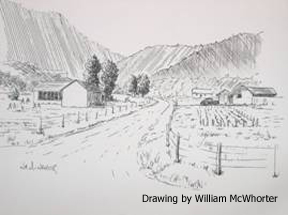 What little studying I did was by a
kerosene lamp. The school was the center of everything. Every night the
school would be open. We had about five teachers when it was a ten-year
school. They had a ten-year school up until the middle of World War II. And
then they started hauling the kids out to Elkins. I did eight years at
Bemis. Right as I started riding the bus, they shortened it to an eight-year
school, I think it was.
What little studying I did was by a
kerosene lamp. The school was the center of everything. Every night the
school would be open. We had about five teachers when it was a ten-year
school. They had a ten-year school up until the middle of World War II. And
then they started hauling the kids out to Elkins. I did eight years at
Bemis. Right as I started riding the bus, they shortened it to an eight-year
school, I think it was.
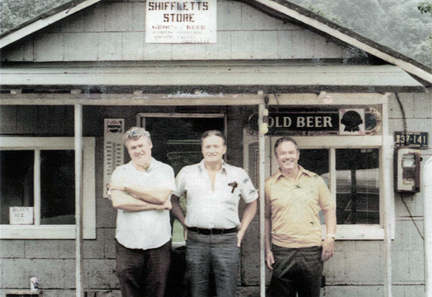 we’d play over there. Then next time it was our turn to
go over to Glady and play. We’d play right below where the school building
set. Back then there was always something going on.
we’d play over there. Then next time it was our turn to
go over to Glady and play. We’d play right below where the school building
set. Back then there was always something going on.
Photo courtesy Calvin Shifflet.
 got married in ‘19, and then he worked on
the railroad over there on the Norfolk and Western Railroad. In ‘25 his brother
was the boss foreman in Bemis, and he wrote him, and I don’t know if Dad
expressed that he wanted to come back, but he wrote him and said they had an
opening if he wanted it. So we come back in ‘25. I said we, but I wasn’t born
yet. My three brothers were born in Virginia, and they come over in ‘25, and we
stayed here. The three oldest were born in Virginia, and the other three were
born in Bemis.
got married in ‘19, and then he worked on
the railroad over there on the Norfolk and Western Railroad. In ‘25 his brother
was the boss foreman in Bemis, and he wrote him, and I don’t know if Dad
expressed that he wanted to come back, but he wrote him and said they had an
opening if he wanted it. So we come back in ‘25. I said we, but I wasn’t born
yet. My three brothers were born in Virginia, and they come over in ‘25, and we
stayed here. The three oldest were born in Virginia, and the other three were
born in Bemis.
Relief at Jewell’s Department Store
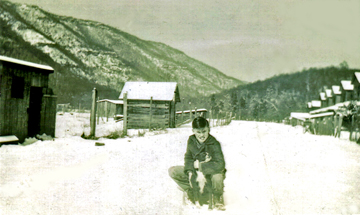 Roosevelt, the
people up here would have starved. When they brought that relief in, they would
stop in Bemis and then on to Glady. I still remember the place—in Bemis it was
the Dahmer Store—that huge big brick building that they just tore down a couple
months ago.
Roosevelt, the
people up here would have starved. When they brought that relief in, they would
stop in Bemis and then on to Glady. I still remember the place—in Bemis it was
the Dahmer Store—that huge big brick building that they just tore down a couple
months ago.
Coal Mine in Bemis
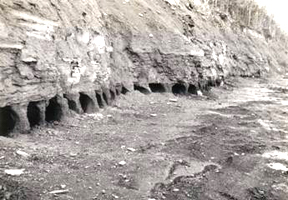
Photo courtesy Monongahela
National Forest.
Red and Black Lines at the Company Store
Hot and Cold in Baltimore
Back Home: Dutch Oven Days, Bemis Store and the Night Club
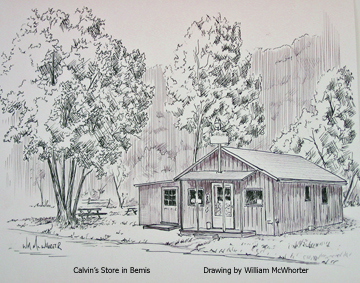 for a number of years. But life in and near Bemis always pulled him
back. Eventually he opened a store in Bemis and became post master/storekeeper
in nearby Glady. Here’s how he describes it:
for a number of years. But life in and near Bemis always pulled him
back. Eventually he opened a store in Bemis and became post master/storekeeper
in nearby Glady. Here’s how he describes it: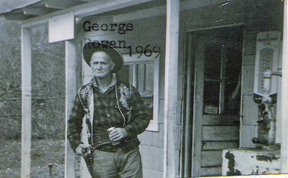 milk
or coffee. I sell quite a bit of coffee. About everybody wants the real coffee,
not the instant. They’ll come in and—especially the old timers—they’ll come in
and ask if I got any boiled coffee; not the other stuff, the boiled coffee. That
means that they don’t want the instant. A lot of the old timers, they just throwed coffee in the can. I used to do it when I was in the Army. It boils for
four–five minutes and the grounds just settle on the bottom. It was pretty
horrible coffee. There was no filters, and the coffee was almost always too
strong but it was coffee. Boiled coffee, the old timers called it.
milk
or coffee. I sell quite a bit of coffee. About everybody wants the real coffee,
not the instant. They’ll come in and—especially the old timers—they’ll come in
and ask if I got any boiled coffee; not the other stuff, the boiled coffee. That
means that they don’t want the instant. A lot of the old timers, they just throwed coffee in the can. I used to do it when I was in the Army. It boils for
four–five minutes and the grounds just settle on the bottom. It was pretty
horrible coffee. There was no filters, and the coffee was almost always too
strong but it was coffee. Boiled coffee, the old timers called it.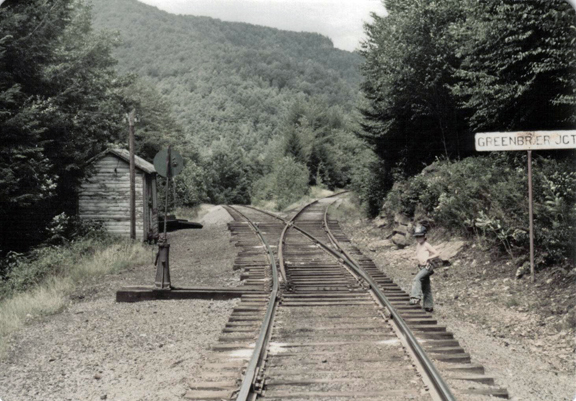
The right line went into a
tunnel that came out the other side of Cheat Mountain
and headed up to Durbin,
the left followed the Shavers Fork further upstream